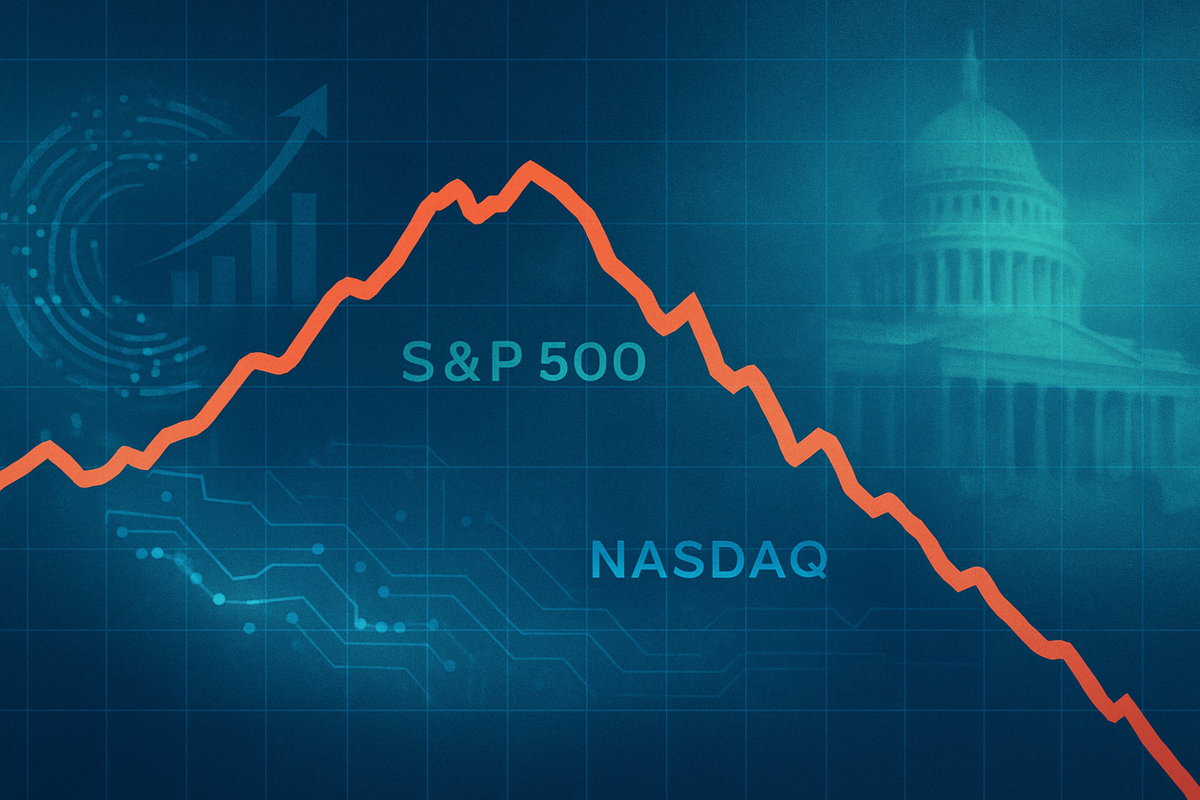
The relentless ascent of the U.S. stock market has hit a significant speed bump, as both the S&P 500 and Nasdaq Composite have retreated from their recent record highs. This pullback, occurring after weeks of robust gains, signals a period of reassessment for investors grappling with a confluence of economic uncertainties, including a prolonged government shutdown, evolving Federal Reserve policy expectations, and growing concerns over elevated valuations in the booming artificial intelligence (AI) sector. The immediate implication is a shift towards increased caution, prompting a reevaluation of market sustainability and investor risk appetite.
This "pause" in the market's upward trajectory is seen by many as a necessary digestion of previous gains, but it also highlights underlying vulnerabilities. As of October 9, 2025, market participants are closely monitoring key economic indicators and central bank communications, understanding that the coming weeks could dictate the market's direction through the end of the year and into 2026. While some view the dip as a potential buying opportunity, the prevailing sentiment leans towards a more circumspect approach, with a keen eye on macroeconomic developments.
Unpacking the Market's Retreat: A Confluence of Factors
The recent retreat of the S&P 500 and Nasdaq Composite is not attributable to a single factor but rather a complex interplay of economic, political, and technical elements. The S&P 500, which had surged approximately 35% since its low in April, and the Nasdaq Composite, driven largely by technology and growth stocks, both experienced a period of intense bullish momentum. This extended rally naturally led to widespread profit-taking as investors locked in gains, particularly in sectors that had seen exponential growth.
A significant driver of market apprehension is the escalating concern over an "AI bubble." The fervor surrounding artificial intelligence technology has propelled many related stocks to unprecedented valuations, leading to fears that the market, particularly in this sector, has become "too high and too expensive." This sentiment suggests that a correction or consolidation might be healthy, preventing a more severe downturn. Simultaneously, the ongoing U.S. government shutdown, now in its second week, casts a long shadow over the economy. The delay in releasing crucial economic data, such as jobless claims and payroll reports, creates a vacuum of information, fostering uncertainty and a cautious investment environment.
Adding to the complexity is the Federal Reserve's (Fed) monetary policy outlook. While there's a general expectation of future interest rate cuts, with a high probability of a cut in October 2025 and more anticipated in 2026/2027, mixed signals from Fed officials and persistent inflation above target are causing traders to re-evaluate the pace and extent of these reductions. Investors are eagerly awaiting remarks from Fed Chair Jerome Powell for clearer guidance. Furthermore, rising bond yields have introduced long liquidation pressures, notably impacting chipmakers and contributing to the broader market retreat, with the 10-year Treasury note yield experiencing an increase. Geopolitical uncertainties and domestic policy issues also continue to contribute to a cautious investment climate. From a technical perspective, the Relative Strength Index (RSI) for the S&P 500 has flashed "overbought" signals, often preceding a healthy pullback or period of consolidation.
Initial market reactions have been characterized by increased caution and a noticeable "risk-off" sentiment. This has led to some flight to safety, with gold reaching record highs before a slight pullback. Investor attention is now sharply focused on upcoming statements from Federal Reserve officials and the impending third-quarter earnings season, which are expected to provide critical insights into the economy's health and corporate performance, thereby guiding future market movements.
Winners and Losers: Navigating the Market Shift
The market's retreat, driven by concerns over AI valuations, rising bond yields, and shifting Fed policy, is creating a clear bifurcation between potential winners and losers.
Companies with exorbitant AI valuations, particularly highly speculative growth stocks in the technology sector, are most vulnerable. Smaller, pure-play AI firms like Aehr Test Systems (NASDAQ: AEHR), which experienced a significant pullback after its earnings report, exemplify the risks for overpriced small caps. Even larger, well-known AI players such as Palantir Technologies (NASDAQ: PLTR) and Arm Holdings (NASDAQ: ARM) are facing scrutiny for their "wildly overvalued" metrics, with Palantir trading at 126 times sales. While diversified, giants like Nvidia (NASDAQ: NVDA), Microsoft (NASDAQ: MSFT), Alphabet (NASDAQ: GOOGL), and Oracle (NYSE: ORCL) could also see corrections if AI adoption or revenue generation falls short of lofty projections. Interest-rate sensitive growth stocks and highly leveraged companies, reliant on cheap capital, will also face headwinds as borrowing costs rise. Cyclical and consumer discretionary companies, whose performance is tied to robust consumer spending, are also likely to suffer if economic slowdown concerns intensify.
Conversely, defensive stocks are poised to outperform during this period of uncertainty. These include consumer staples companies like Procter & Gamble (NYSE: PG) and Coca-Cola (NYSE: KO), and utilities such as Fortis (TSX: FTS) and NextEra Energy (NYSE: NEE), which provide essential goods and services. Healthcare giants like Pfizer (NYSE: PFE) and Johnson & Johnson (NYSE: JNJ) also fall into this category. Value stocks with strong fundamentals, less sensitive to interest rate changes, are also gaining traction. Berkshire Hathaway (NYSE: BRK.A, BRK.B), known for its fortress-like balance sheet, is a prime example. Companies with robust balance sheets and high cash flow, such as Visa (NYSE: V) and Costco Wholesale Corp. (NASDAQ: COST), are better positioned to weather downturns and potentially capitalize on opportunities. Even some financial institutions like JPMorgan Chase (NYSE: JPM) might benefit from rising net interest margins in certain scenarios, though overall market health remains a factor.
Broader Implications and Historical Echoes
This market pullback is not an isolated event but rather fits into broader industry trends, particularly the ongoing investor reassessment of the "AI-driven bubble" and the unprecedented concentration of market capitalization in a few mega-cap technology companies, often dubbed the "Magnificent Seven." This over-reliance on a select group of tech stocks makes the broader market highly susceptible to their performance. As these high-flying growth stocks retreat, a noticeable rotation of capital is emerging, shifting from potentially overvalued AI-related companies towards more defensive sectors like utilities, consumer staples, and healthcare, as investors seek stability and more attractive valuations.
The ripple effects extend beyond direct competitors. A significant correction in mega-cap technology stocks could impact their vast network of suppliers, partners, and even customers. In private markets, stretched valuations in venture capital and private equity could lead to a repricing, making fundraising more challenging for startups. Conversely, companies with strong balance sheets might find strategic opportunities to acquire undervalued assets.
Regulatory and policy implications are significant. The U.S. government shutdown, as of October 2025, is delaying crucial economic data releases, creating a "market data blind spot" that increases uncertainty around monetary policy. It also creates regulatory bottlenecks for agencies like the SEC and FDA, slowing approvals across various sectors. The Federal Reserve's "dovish pivot," with rate cuts initiated in September 2025 and more expected, aims to prevent a severe economic downturn. Lower rates generally support stock markets, especially growth stocks, but persistent inflation concerns mean the path of future cuts remains data-dependent. Beyond the shutdown, the tech sector faces increasing global regulatory scrutiny over data privacy, content moderation, and antitrust, imposing compliance costs and potentially impacting valuations.
Historically, market pullbacks are common. Since 1928, there have been 60 corrections (10%+ decline), with only 17 escalating into bear markets (20%+ decline). A notable parallel is the dot-com bubble of 2000-2002. The current concentration of market cap in a few tech giants (around 35% of the S&P 500) is comparable to the tech sector's weight during the dot-com peak (33% in February 2000), which saw the Nasdaq Composite fall nearly 80%. While current valuations are arguably more robust, the comparison highlights the risks of concentrated market leadership. Despite such declines, U.S. stocks typically rebound relatively quickly, with the S&P 500 often achieving double-digit positive returns within a year after its worst drops.
What Comes Next: Navigating Volatility and Opportunity
The market's retreat ushers in a period of heightened sensitivity and strategic re-evaluation for both investors and companies. In the short term, expect continued volatility, with market sentiment highly susceptible to upcoming economic data, geopolitical developments, and third-quarter corporate earnings reports. Disappointing results from major tech companies, unexpected inflation spikes, or geopolitical shocks could trigger sharp sell-offs. Conversely, this pullback could be a healthy consolidation, with major indexes still holding above key moving averages, potentially leading to a "buy the dip" mentality for long-term investors. However, signs of market breadth fatigue suggest a consolidation phase might be more prolonged.
Long-term possibilities are diverse. While some foresee the S&P 500 surging to 9,000 by 2026 under a "bubble scenario" driven by accelerated capital markets, concerns about an AI-driven bubble persist. A significant correction could force companies to prioritize profitability and sustainable business models over speculative valuations, leading to a healthier tech sector in the long run. Resilient sectors like energy and healthcare are expected to act as buffers against tech-heavy volatility, and AI and robotics, still in early stages, hold substantial potential for future gains.
Strategic pivots are crucial. Investors should prepare for continued volatility through hedging strategies, disciplined "buying the dip," and focusing on relative strength and fundamentals. Diversification into defensive assets like consumer staples, utilities, healthcare, and gold is also prudent. Companies, in turn, must shift towards profitability and sustainable models, strengthen balance sheets, diversify revenue streams, and enhance operational efficiency and supply chain resilience. Leveraging technology, automation, and focusing on core competencies will be vital for survival and growth.
Opportunities include acquiring quality assets at discounted prices for value investors, long-term growth in AI and robotics, and increased interest in defensive and dividend-paying stocks. Challenges stem from overvalued tech stocks, rising borrowing costs for leveraged companies, persistent market volatility, intense scrutiny during earnings season, and rapid shifts in consumer behavior.
Potential scenarios range from a mild, healthy correction followed by continued growth (a "soft landing") to a prolonged, gradual decline or even a severe downturn and recession. In a soft landing, quality stocks present buying opportunities, and companies with strong fundamentals thrive. A grinding bear market demands disciplined strategies and capital preservation, while a severe downturn would trigger a "flight to safety" and substantial opportunities for value investors.
Comprehensive Wrap-Up: A Market in Transition
The recent retreat of the S&P 500 and Nasdaq Composite from their record highs marks a pivotal moment for financial markets. It underscores a fundamental shift from unbridled optimism to a more cautious, scrutinizing environment, driven by concerns over AI valuation bubbles, the economic drag of a government shutdown, and the evolving trajectory of Federal Reserve monetary policy. The key takeaway is that the market is undergoing a necessary period of reassessment and consolidation after an extended bull run.
Moving forward, the market is expected to remain highly sensitive to macroeconomic data, corporate earnings, and geopolitical developments. Investors should anticipate continued volatility and potential further pullbacks, making a disciplined, fundamental-driven approach essential. The rotation from high-growth, speculative tech stocks towards more defensive, value-oriented sectors is likely to persist as investors prioritize stability and proven profitability.
The lasting impact of this event could be a rebalancing of market leadership, fostering a healthier, more sustainable growth environment for the long term. Companies will be pressured to demonstrate clear pathways to profitability and efficient capital allocation, particularly within the AI sector. For investors, the coming months will be critical for identifying resilient businesses with strong balance sheets and consistent cash flows. Watch for clear signals from the Federal Reserve regarding interest rate policy, the resolution of the government shutdown, and the performance of key tech companies during the upcoming earnings season. These factors will be instrumental in shaping the market's trajectory and determining whether this retreat is merely a pause or the harbinger of a more significant shift.
This content is intended for informational purposes only and is not financial advice





